Hexham (UK Parliament constituency)
Hexham is a constituency[n 1] in Northumberland represented in the House of Commons of the UK Parliament since 2010 by Guy Opperman, a Conservative.[n 2]
| Hexham | |
|---|---|
| County constituency for the House of Commons | |
 Boundary of Hexham in Northumberland | |
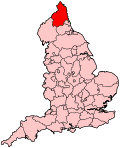 Location of Northumberland within England | |
| County | Northumberland |
| Electorate | 60,499 (December 2010)[1] |
| Major settlements | Hexham, Corbridge, Stocksfield, Ponteland, Prudhoe, Wylam, Haydon Bridge, Haltwhistle |
| Current constituency | |
| Created | 1885 |
| Member of Parliament | Guy Opperman (Conservative) |
| Number of members | One |
| Created from | North Northumberland and South Northumberland |
Constituency profile
This large seat reaches to the Pennines and is traversed by Hadrian's Wall, which runs almost due east–west through England. It includes substantial agricultural holdings, forestry, wood processing, food, minerals, and manufactured hardware industries. It has been held by the Conservative Party and rarely with only marginal majorities since 1924. In the midst of the northwest of the area is Kielder Water and running between this area and the middle of the seat is the southern portion of Kielder Forest, and in the west, the attractions of the precipitous Haltwhistle Burn, Viaduct and Castle. SSE of Hexham is the Derwent Reservoir.[2] As well as those rural areas, the constituency also includes part of Newcastle's middle-class suburbs.
Hexham was the only Conservative seat in the North East between 1997–2010, and the only one in Northumberland from 1973 until the Conservatives won Berwick-upon-Tweed in 2015. Despite this middle-class population there are also some more working-class areas: Prudhoe frequently elects Labour councillors and has demographics similar to neighbouring parts of Blaydon, a safe Labour seat. There is also some deprivation in rural areas, particularly around Haltwhistle.
Based on the latest published old age dependency ratios, a slightly larger proportion of the electorate than the national average is retired.[3] In 1997 the Labour Party nearly won the seat, but more usually Hexham is a safe seat for the Conservative party.[4]
History
The seat was created under the Redistribution of Seats Act 1885. Colonel Douglas Clifton Brown, who was Speaker of the House of Commons during the latter years of the World War II, represented the seat for two separate tenures (from 1918–23, and from 1924–51).
Boundaries
The constituency is named after the town of Hexham in Northumberland. It includes the former Tynedale district and part of the former Castle Morpeth district.[n 3]
Boundary review
Following their review of parliamentary representation in Northumberland, the Boundary Commission for England has made only minor changes to the existing boundaries of the Hexham constituency. The electoral wards used in its formation are:
- The entire former district of Tynedale
- The former Castle Morpeth wards of Heddon-on-the-Wall, Ponteland East, Ponteland North, Ponteland South, Ponteland West, Stamfordham and Stannington
Members of Parliament
| Year | Member[5] | Party | |
|---|---|---|---|
| 1885 | Miles MacInnes | Liberal | |
| 1892 | Nathaniel Clayton | Conservative | |
| 1893 | Miles MacInnes | Liberal | |
| 1895 | Wentworth Beaumont | ||
| 1907 | Richard Durning Holt | ||
| 1918 | Douglas Clifton Brown | Unionist | |
| 1923 | Victor Finney | Liberal | |
| 1924 | Douglas Clifton Brown | Unionist | |
| 1943 | Speaker | ||
| 1951 | Rupert Speir | Conservative | |
| 1966 | Geoffrey Rippon | ||
| 1987 | Alan Amos | ||
| 1992 | Peter Atkinson | ||
| 2010 | Guy Opperman | ||
Elections
Elections in the 2010s
| Party | Candidate | Votes | % | ± | |
|---|---|---|---|---|---|
| Conservative | Guy Opperman | 25,152 | 54.5 | ||
| Labour | Penny Grennan | 14,603 | 31.6 | ||
| Liberal Democrats | Stephen Howse | 4,672 | 10.1 | ||
| Green | Nick Morphet | 1,723 | 3.7 | ||
| Majority | 10,549 | 22.9 | |||
| Turnout | 46,150 | 75.3 | |||
| Conservative hold | Swing | ||||
| Party | Candidate | Votes | % | ± | |
|---|---|---|---|---|---|
| Conservative | Guy Opperman | 24,996 | 54.1 | ||
| Labour Co-op | Stephen Powers | 15,760 | 34.1 | ||
| Liberal Democrats | Fiona Hall | 3,285 | 7.1 | ||
| Green | Wesley Foot | 1,253 | 2.7 | ||
| UKIP | Francis Miles | 930 | 2.0 | ||
| Majority | 9,236 | 20.0 | |||
| Turnout | 46,224 | 75.1 | |||
| Conservative hold | Swing | ||||
| Party | Candidate | Votes | % | ± | |
|---|---|---|---|---|---|
| Conservative | Guy Opperman | 22,834 | 52.7 | ||
| Labour | Liam Carr | 10,803 | 24.9 | ||
| UKIP | David Nicholson | 4,302 | 9.9 | N/A | |
| Liberal Democrats | Jeff Reid[8] | 2,961 | 6.8 | ||
| Green | Lee Williscroft-Ferris | 2,445 | 5.6 | ||
| Majority | 12,031 | 27.8 | |||
| Turnout | 43,345 | 71.5 | |||
| Conservative hold | Swing | ||||
| Party | Candidate | Votes | % | ± | |
|---|---|---|---|---|---|
| Conservative | Guy Opperman | 18,795 | 43.2 | ||
| Liberal Democrats | Andrew Duffield | 13,007 | 29.9 | ||
| Labour | Antoine Tinnion | 8,253 | 19.0 | ||
| Independent | Steven Ford | 1,974 | 4.5 | N/A | |
| BNP | Quentin Hawkins | 1,205 | 2.8 | N/A | |
| Independent | Colin Moss | 249 | 0.6 | N/A | |
| Majority | 5,788 | 13.3 | |||
| Turnout | 43,483 | 70.8 | |||
| Conservative hold | Swing | ||||
Elections in the 2000s
| Party | Candidate | Votes | % | ± | |
|---|---|---|---|---|---|
| Conservative | Peter Atkinson | 17,605 | 42.4 | −2.2 | |
| Labour | Kevin Graham | 12,585 | 30.3 | −8.3 | |
| Liberal Democrats | Andrew Duffield | 10,673 | 25.7 | +10.7 | |
| English Democrat | Ian Riddell | 521 | 1.3 | +1.3 | |
| Imperial | Thomas Davison | 129 | 0.3 | +0.3 | |
| Majority | 5,020 | 12.1 | |||
| Turnout | 41,513 | 68.8 | −2.1 | ||
| Conservative hold | Swing | +3.0 | |||
| Party | Candidate | Votes | % | ± | |
|---|---|---|---|---|---|
| Conservative | Peter Atkinson | 18,917 | 44.6 | +5.8 | |
| Labour | Paul Brannen | 16,388 | 38.6 | +0.4 | |
| Liberal Democrats | Philip Latham | 6,380 | 15.0 | −2.4 | |
| UKIP | Alan Patterson | 728 | 1.7 | −0.8 | |
| Majority | 2,529 | 6.0 | |||
| Turnout | 42,413 | 70.9 | −6.6 | ||
| Conservative hold | Swing | ||||
Elections in the 1990s
| Party | Candidate | Votes | % | ± | |
|---|---|---|---|---|---|
| Conservative | Peter Atkinson | 17,701 | 38.8 | -13.6 | |
| Labour | Ian McMinn | 17,479 | 38.2 | +14.0 | |
| Liberal Democrats | Philip Carr | 7,959 | 17.4 | -4.3 | |
| Referendum | Robert Waddell | 1,362 | 3.0 | ||
| UKIP | David Lott | 1,170 | 2.6 | ||
| Majority | 222 | 0.6 | -27.6 | ||
| Turnout | 45,671 | 77.5 | -4.9 | ||
| Conservative hold | Swing | +13.8 | |||
| Party | Candidate | Votes | % | ± | |
|---|---|---|---|---|---|
| Conservative | Peter Atkinson | 24,967 | 52.4 | +2.8 | |
| Labour | Ian Swithenbank | 11,529 | 24.2 | +6.2 | |
| Liberal Democrats | Jonathan Wallace | 10,344 | 21.7 | −10.0 | |
| Green | John Hartshorne | 781 | 1.6 | +0.9 | |
| Majority | 13,438 | 28.2 | +10.3 | ||
| Turnout | 47,621 | 82.4 | +2.3 | ||
| Conservative hold | Swing | −1.7 | |||
Elections in the 1980s
| Party | Candidate | Votes | % | ± | |
|---|---|---|---|---|---|
| Conservative | Alan Amos | 22,370 | 49.6 | ||
| Liberal | Euan Robson | 14,304 | 31.7 | ||
| Labour | Mike Wood | 8,103 | 18.0 | ||
| Green | Sheila Wood | 336 | 0.7 | ||
| Majority | 8,066 | 17.9 | |||
| Turnout | 80.0 | ||||
| Conservative hold | Swing | ||||
| Party | Candidate | Votes | % | ± | |
|---|---|---|---|---|---|
| Conservative | Geoffrey Rippon | 21,374 | 51.5 | ||
| Liberal | Euan Robson | 13,066 | 31.5 | ||
| Labour | Stephen Byers | 7,056 | 17.0 | ||
| Majority | 8,308 | 20.0 | |||
| Turnout | 73.36 | ||||
| Conservative hold | Swing | ||||
Elections in the 1970s
| Party | Candidate | Votes | % | ± | |
|---|---|---|---|---|---|
| Conservative | Geoffrey Rippon | 25,483 | 48.0 | ||
| Labour | Stuart Bell | 16,935 | 31.9 | ||
| Liberal | John Shipley | 10,697 | 20.1 | ||
| Majority | 8,548 | 16.1 | |||
| Turnout | 79.5 | ||||
| Conservative hold | Swing | ||||
| Party | Candidate | Votes | % | ± | |
|---|---|---|---|---|---|
| Conservative | Geoffrey Rippon | 21,352 | 43.53 | ||
| Labour | Eric Wade | 16,711 | 34.07 | ||
| Liberal | Roy Cairncross | 10,991 | 22.41 | ||
| Majority | 4,641 | 9.46 | |||
| Turnout | 75.37 | ||||
| Conservative hold | Swing | ||||
| Party | Candidate | Votes | % | ± | |
|---|---|---|---|---|---|
| Conservative | Geoffrey Rippon | 24,059 | 45.46 | ||
| Labour | Eric Wade | 16,129 | 30.48 | ||
| Liberal | Roy Cairncross | 12,730 | 24.06 | ||
| Majority | 7,930 | 14.99 | |||
| Turnout | 82.62 | ||||
| Conservative hold | Swing | ||||
| Party | Candidate | Votes | % | ± | |
|---|---|---|---|---|---|
| Conservative | Geoffrey Rippon | 24,516 | 51.96 | ||
| Labour | John E Miller | 16,645 | 35.28 | ||
| Liberal | David Cogan | 6,021 | 12.76 | ||
| Majority | 7,871 | 16.68 | |||
| Turnout | 75.31 | ||||
| Conservative hold | Swing | ||||
Elections in the 1960s
| Party | Candidate | Votes | % | ± | |
|---|---|---|---|---|---|
| Conservative | Geoffrey Rippon | 20,889 | 48.10 | ||
| Labour | James B. Lamb | 16,105 | 37.08 | ||
| Liberal | Douglas A. Robson | 6,434 | 14.82 | ||
| Majority | 4,784 | 11.02 | |||
| Turnout | 78.05 | ||||
| Conservative hold | Swing | ||||
| Party | Candidate | Votes | % | ± | |
|---|---|---|---|---|---|
| Conservative | Rupert Speir | 22,468 | 50.70 | ||
| Labour | John Alderson | 14,127 | 31.88 | ||
| Liberal | Douglas A. Robson | 7,722 | 17.42 | ||
| Majority | 8,341 | 18.82 | |||
| Turnout | 81.88 | ||||
| Conservative hold | Swing | ||||
Elections in the 1950s
| Party | Candidate | Votes | % | ± | |
|---|---|---|---|---|---|
| Conservative | Rupert Speir | 25,500 | 62.99 | ||
| Labour | Wilfrid Roberts | 14,980 | 37.01 | ||
| Majority | 10,520 | 25.99 | |||
| Turnout | 81.11 | ||||
| Conservative hold | Swing | ||||
| Party | Candidate | Votes | % | ± | |
|---|---|---|---|---|---|
| Conservative | Rupert Speir | 23,462 | 64.00 | ||
| Labour | Edward Garrett | 13,198 | 36.00 | ||
| Majority | 10,264 | 28.00 | |||
| Turnout | 77.28 | ||||
| Conservative hold | Swing | ||||
| Party | Candidate | Votes | % | ± | |
|---|---|---|---|---|---|
| Conservative | Rupert Speir | 23,267 | 59.61 | ||
| Labour Co-op | Thomas L. MacDonald | 15,768 | 40.39 | ||
| Majority | 7,499 | 19.21 | |||
| Turnout | 82.42 | ||||
| Conservative gain from Speaker | Swing | ||||
| Party | Candidate | Votes | % | ± | |
|---|---|---|---|---|---|
| Speaker | Douglas Clifton Brown | 24,703 | 85.06 | ||
| Independent Liberal | Alexander Hancock | 4,154 | 14.40 | ||
| Majority | 20,549 | 71.21 | |||
| Turnout | 61.88 | ||||
| Speaker hold | Swing | ||||
Elections in the 1940s
| Party | Candidate | Votes | % | ± | |
|---|---|---|---|---|---|
| Speaker | Douglas Clifton Brown | 16,431 | 58.23 | ||
| Labour | Ernest Kavanagh | 11,786 | 41.77 | ||
| Majority | 4,645 | 16.46 | |||
| Turnout | 73.80 | ||||
| Speaker hold | Swing | ||||
- 1943: Douglas Clifton-Brown becomes Speaker of the House of Commons.
Elections in the 1930s
| Party | Candidate | Votes | % | ± | |
|---|---|---|---|---|---|
| Conservative | Douglas Clifton Brown | 17,241 | 62.55 | ||
| Labour | Ernest Kinghorn | 10,324 | 37.45 | ||
| Majority | 6,917 | 25.09 | |||
| Turnout | 75.92 | ||||
| Conservative hold | Swing | ||||
| Party | Candidate | Votes | % | ± | |
|---|---|---|---|---|---|
| Conservative | Douglas Clifton Brown | 20,578 | 73.14 | ||
| Labour | E. O. Dunnico | 7,557 | 26.86 | ||
| Majority | 13,021 | 46.28 | |||
| Turnout | 79.21 | ||||
| Conservative hold | Swing | ||||
Elections in the 1920s
| Party | Candidate | Votes | % | ± | |
|---|---|---|---|---|---|
| Unionist | Douglas Clifton Brown | 11,069 | 39.1 | −8.9 | |
| Liberal | Francis Acland | 9,103 | 32.2 | +2.9 | |
| Labour | Ernest Owen Dunnico | 8,135 | 28.7 | +6.0 | |
| Majority | 1,966 | 6.9 | −11.8 | ||
| Turnout | 28,307 | 80.2 | −2.0 | ||
| Registered electors | 35,304 | ||||
| Unionist hold | Swing | −5.9 | |||
| Party | Candidate | Votes | % | ± | |
|---|---|---|---|---|---|
| Unionist | Douglas Clifton Brown | 10,741 | 48.0 | +4.0 | |
| Liberal | Victor Finney | 6,551 | 29.3 | −26.7 | |
| Labour | Charles Flynn | 5,089 | 22.7 | N/A | |
| Majority | 4,190 | 18.7 | N/A | ||
| Turnout | 22,381 | 82.2 | +6.7 | ||
| Registered electors | 27,237 | ||||
| Unionist gain from Liberal | Swing | +15.4 | |||
| Party | Candidate | Votes | % | ± | |
|---|---|---|---|---|---|
| Liberal | Victor Finney | 11,293 | 56.0 | +25.0 | |
| Unionist | Douglas Clifton Brown | 8,887 | 44.0 | −0.8 | |
| Majority | 2,406 | 12.0 | N/A | ||
| Turnout | 20,180 | 75.6 | −3.7 | ||
| Registered electors | 26,732 | ||||
| Liberal gain from Unionist | Swing | +12.9 | |||
| Party | Candidate | Votes | % | ± | |
|---|---|---|---|---|---|
| Unionist | Douglas Clifton Brown | 9,369 | 44.8 | −4.1 | |
| Liberal | Victor Finney | 6,486 | 31.0 | +6.1 | |
| Labour | George Shield | 5,050 | 24.2 | −2.0 | |
| Majority | 2,883 | 13.8 | −8.9 | ||
| Turnout | 20,905 | 79.3 | +16.9 | ||
| Registered electors | 26,372 | ||||
| Unionist hold | Swing | −5.1 | |||
Elections in the 1910s
| Party | Candidate | Votes | % | ± | |
|---|---|---|---|---|---|
| C | Unionist | Douglas Clifton Brown | 7,763 | 48.9 | +3.1 |
| Labour | William Weir | 4,168 | 26.2 | N/A | |
| Liberal | Wentworth Beaumont | 3,948 | 24.9 | −29.3 | |
| Majority | 3,595 | 22.7 | N/A | ||
| Turnout | 15,879 | 62.4 | −21.0 | ||
| Registered electors | 25,341 | ||||
| Unionist gain from Liberal | Swing | +16.2 | |||
| C indicates candidate endorsed by the coalition government. | |||||
General Election 1914/15:

Another General Election was required to take place before the end of 1915. The political parties had been making preparations for an election to take place and by the July 1914, the following candidates had been selected:
- Liberal: Richard Durning Holt
- Unionist: Alan Percy [19]
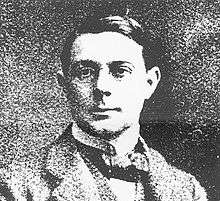
| Party | Candidate | Votes | % | ± | |
|---|---|---|---|---|---|
| Liberal | Richard Durning Holt | 5,124 | 54.2 | −1.2 | |
| Conservative | Alfred Henry Chaytor | 4,334 | 45.8 | +1.2 | |
| Majority | 790 | 8.4 | −2.4 | ||
| Turnout | 9,458 | 83.4 | −3.9 | ||
| Registered electors | 11,335 | ||||
| Liberal hold | Swing | −1.2 | |||
| Party | Candidate | Votes | % | ± | |
|---|---|---|---|---|---|
| Liberal | Richard Durning Holt | 5,478 | 55.4 | −6.0 | |
| Conservative | Charles Loftus Bates | 4,417 | 44.6 | +6.0 | |
| Majority | 1,061 | 10.8 | −12.0 | ||
| Turnout | 9,895 | 87.3 | +4.2 | ||
| Registered electors | 11,335 | ||||
| Liberal hold | Swing | −6.0 | |||
Elections in the 1900s
| Party | Candidate | Votes | % | ± | |
|---|---|---|---|---|---|
| Liberal | Richard Durning Holt | 5,401 | 56.0 | −5.4 | |
| Conservative | Charles Loftus Bates | 4,244 | 44.0 | +5.4 | |
| Majority | 1,157 | 12.0 | −10.8 | ||
| Turnout | 9,645 | 86.8 | +3.7 | ||
| Registered electors | 11,116 | ||||
| Liberal hold | Swing | −5.4 | |||
| Party | Candidate | Votes | % | ± | |
|---|---|---|---|---|---|
| Liberal | Wentworth Beaumont | 5,632 | 61.4 | +10.3 | |
| Conservative | Nathaniel George Clayton | 3,547 | 38.6 | −10.3 | |
| Majority | 2,085 | 22.8 | +20.6 | ||
| Turnout | 9,179 | 83.1 | +3.5 | ||
| Registered electors | 11,049 | ||||
| Liberal hold | Swing | +10.3 | |||
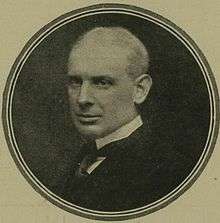
| Party | Candidate | Votes | % | ± | |
|---|---|---|---|---|---|
| Liberal | Wentworth Beaumont | 4,197 | 51.1 | −1.5 | |
| Liberal Unionist | Charles Howard | 4,011 | 48.9 | +1.5 | |
| Majority | 186 | 2.2 | −3.0 | ||
| Turnout | 8,208 | 79.6 | −2.2 | ||
| Registered electors | 10,310 | ||||
| Liberal hold | Swing | −1.5 | |||
Elections in the 1890s
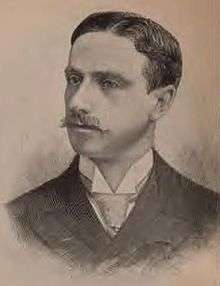
| Party | Candidate | Votes | % | ± | |
|---|---|---|---|---|---|
| Liberal | Wentworth Beaumont | 4,438 | 52.6 | +3.1 | |
| Conservative | Charles Edward Hunter | 4,003 | 47.4 | −3.1 | |
| Majority | 435 | 5.2 | N/A | ||
| Turnout | 8,441 | 81.8 | +0.4 | ||
| Registered electors | 10,316 | ||||
| Liberal gain from Conservative | Swing | +3.1 | |||
| Party | Candidate | Votes | % | ± | |
|---|---|---|---|---|---|
| Liberal | Miles MacInnes | 4,804 | 52.4 | +2.9 | |
| Conservative | Richard Clayton | 4,358 | 47.6 | −2.9 | |
| Majority | 446 | 4.8 | N/A | ||
| Turnout | 9,162 | 87.3 | +5.9 | ||
| Registered electors | 10,494 | ||||
| Liberal gain from Conservative | Swing | +2.9 | |||
- Caused after the 1892 result was declared void on petition.
| Party | Candidate | Votes | % | ± | |
|---|---|---|---|---|---|
| Conservative |
|
4,092 | 50.5 | +7.0 | |
| Liberal | Miles MacInnes | 4,010 | 49.5 | -7.0 | |
| Majority | 82 | 1.0 | N/A | ||
| Turnout | 8,102 | 81.4 | +9.1 | ||
| Registered electors | 9,954 | ||||
| Conservative gain from Liberal | Swing | +7.0 | |||
- Clayton was unseated on petition
Elections in the 1880s

| Party | Candidate | Votes | % | ± | |
|---|---|---|---|---|---|
| Liberal | Miles MacInnes | 4,177 | 56.5 | -2.1 | |
| Conservative | Gilbert Elliot-Murray-Kynynmound | 3,220 | 43.5 | +2.1 | |
| Majority | 957 | 13.0 | -4.2 | ||
| Turnout | 7,397 | 72.3 | −14.2 | ||
| Registered electors | 10,237 | ||||
| Liberal hold | Swing | -2.1 | |||
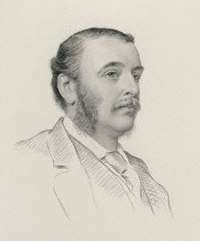
| Party | Candidate | Votes | % | ± | |
|---|---|---|---|---|---|
| Liberal | Miles MacInnes | 5,193 | 58.6 | N/A | |
| Conservative | Matthew Ridley | 3,663 | 41.4 | N/A | |
| Majority | 1,530 | 17.2 | N/A | ||
| Turnout | 8,856 | 86.5 | N/A | ||
| Registered electors | 10,237 | ||||
| Liberal win (new seat) | |||||
Notes and references
- Notes
- A county constituency (for the purposes of election expenses and type of returning officer)
- As with all constituencies, the constituency elects one Member of Parliament (MP) by the first past the post system of election at least every five years.
- Tynedale and Castle Morpeth district councils were abolished in April 2009 in favour of a unitary Northumberland County Council.
- References
Craig, F. W. S. (1983). British parliamentary election results 1918-1949 (3 ed.). Chichester: Parliamentary Research Services. ISBN 0-900178-06-X.
- "Electorate Figures - Boundary Commission for England". 2011 Electorate Figures. Boundary Commission for England. 4 March 2011. Archived from the original on 6 November 2010. Retrieved 13 March 2011.
- "OS Maps - online and App mapping system | Ordnance Survey Shop". getamap.ordnancesurvey.co.uk.
- "2011 census interactive maps". Archived from the original on January 29, 2016.
- "Local statistics - Office for National Statistics". www.ons.gov.uk.
- Leigh Rayment's Historical List of MPs – Constituencies beginning with "H" (part 3)
- "Hexham Parliamentary constituency". BBC News. BBC. Retrieved 24 November 2019.
- "Election Data 2015". Electoral Calculus. Archived from the original on 17 October 2015. Retrieved 17 October 2015.
- Daniel, Brian. "Lib Dem Jeff Reid to battle Tory MP Guy Opperman at general election - The Journal". www.thejournal.co.uk.
- "Election Data 2010". Electoral Calculus. Archived from the original on 26 July 2013. Retrieved 17 October 2015.
- "BBC NEWS – Election 2010 – Hexham". BBC News.
- "Election Data 2005". Electoral Calculus. Archived from the original on 15 October 2011. Retrieved 18 October 2015.
- "Election Data 2001". Electoral Calculus. Archived from the original on 15 October 2011. Retrieved 18 October 2015.
- "Election Data 1997". Electoral Calculus. Archived from the original on 15 October 2011. Retrieved 18 October 2015.
- "Election Data 1992". Electoral Calculus. Archived from the original on 15 October 2011. Retrieved 18 October 2015.
- "Politics Resources". Election 1992. Politics Resources. 9 April 1992. Archived from the original on 24 July 2011. Retrieved 2010-12-06.
- "Election Data 1987". Electoral Calculus. Archived from the original on 15 October 2011. Retrieved 18 October 2015.
- "Election Data 1983". Electoral Calculus. Archived from the original on 15 October 2011. Retrieved 18 October 2015.
- The Times' Guide to the House of Commons. 1951.
- Newcastle Journal 12 Mar 1914
- Craig, FWS, ed. (1974). British Parliamentary Election Results: 1885-1918. London: Macmillan Press. ISBN 9781349022984.
- Debrett's House of Commons & Judicial Bench, 1916
- The Liberal Year Book, 1907
- Debrett's House of Commons & Judicial Bench, 1901
- Debrett's House of Commons & Judicial Bench, 1886
| Parliament of the United Kingdom | ||
|---|---|---|
| Preceded by Daventry |
Constituency represented by the Speaker 1943–1951 |
Succeeded by Cirencester and Tewkesbury |